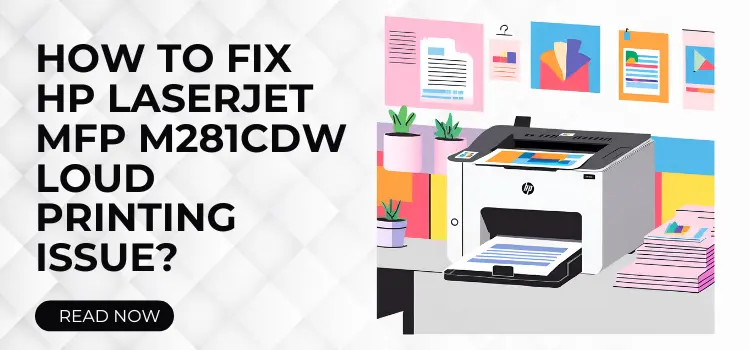No one else has heard your HP LaserJet MFP m281cdw make such a deafening racket while printing. This problem affects a lot of people and can be annoying even in peaceful settings like the office or at home. Even if the HP LaserJet MFP m281cdw consistently produces high-quality prints, if it starts making a lot of noise while printing, there might be a problem that needs fixing.
This blog will discuss typical reasons for noisy printing, including mechanical wear, misaligned parts, or the necessity of regular maintenance. In addition, we will give you practical techniques to troubleshoot and fix the problem. If your printer isn’t running smoothly or quietly, this tutorial will walk you through every step, from checking the paper bin and rollers to updating the firmware.
Whether the noise is emanating from internal components, settings, or outside influences, we’ll show you how to solve it yourself before you call a pro. With the knowledge you get from this blog, you will be able to keep your HP LaserJet MFP m281cdw in excellent working order and print with less noise and greater efficiency.
Possible Causes Behind HP Laserjet MFP m281cdw Loud Printing Issue
Let’s take a look at the list of possible reasons and factors due to why you may encounter the loud printing issue on your HP Laserjet MFP m281cdw printer:
- Roller Wear: When your printer’s rollers wear out, you may hear grinding or squeaking noises during printing.
- When tiny pieces of paper or other debris become lodged inside the printer, they can impede its normal operation and cause it to make a lot of noise.
- An improperly loaded or aligned paper tray could be the cause of unusual printing noises.
- Noise can result from misalignment or mechanical tension from a toner cartridge that isn’t properly positioned or functioning.
- Issues with firmware: If the firmware on your printer is out of date, it could cause hardware miscommunication, which in turn could cause strange noises and operations.
- Problematic or Loose Gears: If the printer’s mechanical gears are worn or loose, it could produce annoying grinding or clicking noises.
- The printer could make a rumbling sound if it has trouble picking up paper from an overloaded or improperly loaded paper tray.
How to Fix HP Laserjet MFP m281cdw Loud Printing Issue?
Once you have identified the potential causes of the error, it’s time to investigate the most effective solutions you can implement on your printer to resolve the loud printing issue.
Solution 1. Clean or Replace Worn Rollers
You might hear grinding or squeaking from the worn-out rollers. Remove any dust or dirt from the rollers by wiping them off with a lint-free cloth dampened with a little water or rubbing alcohol. If the rollers show significant wear, you might need to replace them to restore normal operation.
- Unplug the printer and turn it off.
- Find the rollers (usually inside the paper tray or next to the paper feed) and open the access doors.
- Use a lint-free cloth lightly wet with water or rubbing alcohol to carefully wipe the rollers.
- After a few minutes of drying, shut the printer’s access doors and turn it back on.
- Check the user handbook for the roller part numbers and consider changing them if the noise continues.
Solution 2. Clear Paper Jams or Debris
Inspect the printer thoroughly for any debris or paper jams that may be obstructing the paper path. After removing the toner cartridge, carefully open all access panels and check the paper feed area and rollers for any debris. You can reduce noise by removing any obstacles.
- The first step is to open the paper tray and search for any potentially stuck pieces of paper.
- If any paper gets stuck or ripped, carefully take it out in the same direction as the paper trail to keep it from getting trapped again.
- After that, take out the toner cartridge and look inside the machine for any more dust or debris.
- Step four involves printing a test page to determine whether the printer has become quieter after reassembly.
Solution 3. Adjust the Paper Tray
Never overload the paper tray, and always make sure it is properly oriented. Printing incorrectly loaded paper can result in the printer making an audible screech. Make sure the paper guides are snug but not too tight when inserting the tray into the printer to facilitate easy paper removal.
- First, take the paper tray out of the printer and turn it off.
- Make sure the paper guides in the tray are just the right snug fit for the paper.
- Verify the tray’s capacity in the user handbook to ensure it isn’t overfilled.
- Make sure the tray clicks into place before completely reinserting it.
- Ensure there is no noise by turning the printer back on.
Solution 4: Reinstall or Replace the Toner Cartridge
The toner cartridge may make a noise if it is faulty or not inserted correctly. Remove the toner cartridge and reinstall it, ensuring proper seating this time. To see if it helps, try using a different cartridge.
- Open the front panel and switch off the printer.
- Carefully take out the toner cartridge.
- Check the cartridge for misalignment or damage.
- Subsequently, reinstall it by sliding it back into position until it clicks.
- Now, try using a different toner cartridge and repeat steps one to four if the noise persists.
Read Also:- Fix HP Printer Error Code 0XC4EB827F
Conclusion
Finally, resolving the noisy printing issue with your HP LaserJet MFP m281cdw is not a complex task. Due to the wide variety of possible reasons (such as worn rollers, paper jams, misaligned toner cartridges, and out-of-date firmware), a methodical approach to troubleshooting is required. Get your printer running smoothly and quietly again by fixing common noise issues with the help of this article.
Updating the firmware, cleaning the rollers, and adjusting the paper tray are all examples of routine maintenance that can help keep issues at bay. If the noise persists even after attempting these solutions, it may be necessary to hire professionals to inspect the internal components. With regular maintenance, your HP LaserJet MFP m281cdw will keep producing crisp, clear prints with minimal noise and maximum efficiency.

